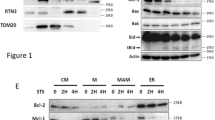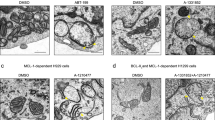Abstract
The mitochondrial apoptosis pathway mediates cell death through the release of various pro-apoptotic factors including cytochrome c and Smac, the second mitochondrial activator of caspases, into the cytosol. Smac was shown previously to inhibit IAP proteins and to facilitate initiation of the caspase cascade upon cytochrome c release. To investigate Smac function during apoptosis and to explore Smac as an experimental cancer therapeutic, we constructed an expression system based on a single adenoviral vector containing Smac under control of the Tet-off system supplied in cis. Conditional expression of Smac induced apoptosis in human HCT116 and DU145 carcinoma cells regardless of the loss of Bax or overexpression of Bcl-xL. Nevertheless, apoptosis induced by Smac was associated with cytochrome c release and breakdown of the mitochondrial membrane potential. This indicates that Smac acts independently of Bax and Bcl-xL during initiation of apoptosis and triggers a positive feedback loop that results in Bax/Bcl-xL-independent activation of mitochondria. In caspase-proficient cells, Smac-induced apoptosis could be inhibited partially by cell-permeable LEHD (caspase-9 inhibitor) and DEVD (caspase-3 inhibitor) peptides. Furthermore, loss of caspase-3 expression in MCF-7 cells carrying a caspase-3 null mutation completely abrogated the sensitivity for Smac-induced apoptotic or nonapoptotic, necrosis-like cell death, while re-expression of caspase-3 conferred sensitivity. Altogether, caspase-3 but not caspase-9 activation was necessary for execution of Smac-induced cell death. Notably, Smac did not induce caspase-9 processing in the absence of caspase-3. Thus, caspase-9 processing occurs secondary to caspase-3 activation during Smac-induced apoptosis. Altogether, Smac is capable of circumventing defects in mitochondrial apoptosis signaling such as loss of Bax or overexpression of Bcl-xL that are frequently observed in tumor cells resistant to anticancer therapy. Consequently, Smac appears to be a promising therapeutic target in anticancer treatment.
This is a preview of subscription content, access via your institution
Access options
Subscribe to this journal
Receive 50 print issues and online access
$259.00 per year
only $5.18 per issue
Buy this article
- Purchase on Springer Link
- Instant access to full article PDF
Prices may be subject to local taxes which are calculated during checkout












Similar content being viewed by others
References
Anderson RD, Haskell RE, Xia H, Roessler BJ and Davidson BL . (2000). Gene Therapy, 7, 1034–1038.
Bosanquet AG, Sturm I, Wieder T, Essmann F, Bosanquet MI, Head DJ, Dörken B and Daniel PT . (2002). Leukemia, 16, 1035–1044.
Brand K, Arnold W, Bartels T, Lieber A, Kay MA, Strauss M and Dörken B . (1997). Cancer Gene Ther., 4, 9–16.
Chai J, Du C, Wu JW, Kyin S, Wang X and Shi Y . (2000). Nature, 406, 855–862.
Cosset FL, Takeuchi Y, Battini JL, Weiss RA and Collins MK . (1995). J. Virol., 69, 7430–7436.
Daniel PT, Sturm I, Ritschel S, Friedrich K, Dörken B, Bendzko P and Hillebrand T . (1999). Anal. Biochem., 266, 110–115.
Du C, Fang M, Li Y, Li L and Wang X . (2000). Cell, 102, 33–42.
Ekert PG, Silke J, Hawkins CJ, Verhagen AM and Vaux DL . (2001). J. Cell Biol., 152, 483–490.
Friedrich K, Wieder T, von Haefen C, Radetzki S, Schulze-Osthoff K, Jänicke R, Dörken B and Daniel PT . (2001). Oncogene, 20, 2749–2760.
Fulda S, Wick W, Weller M and Debatin KM . (2002). Nat. Med., 8, 808–815.
Gillissen B, Essmann F, Graupner V, Stärck L, Radetzki S, Dörken B, Schulze-Osthoff K and Daniel PT . (2003). EMBO J., 22, 3580–3590.
Gossen M and Bujard H . (1992). Proc. Natl. Acad. Sci. USA, 89, 5547–5551.
Güner D, Sturm I, Hemmati PG, Hermann S, Hauptmann S, Wurm R, Budach V, Dörken B, Lorenz M and Daniel PT . (2003). Int. J. Cancer, 103, 445–454.
Guo F, Nimmanapalli R, Paranawithana S, Wittman S, Griffin D, Bali P, O'Bryan E, Fumero C, Wang HG and Bhalla K . (2002). Blood, 99, 3419–3426.
Hemmati PG, Gillissen B, von Haefen C, Wendt J, Stärck L, Güner D, Dörken B and Daniel PT . (2002). Oncogene, 21, 3149–3161.
Jänicke RU, Sprengart ML, Wati MR and Porter AG . (1998). J. Biol. Chem., 273, 9357–9360.
Li LY, Luo X and Wang X . (2001). Nature, 412, 95–99.
Lorenzo HK, Susin SA, Penninger J and Kroemer G . (1999). Cell Death Differ., 6, 516–524.
Martinou JC and Green DR . (2001). Nat. Rev. Mol. Cell Biol., 2, 63–67.
Mrozek A, Petrowsky H, Sturm I, Krauss J, Hermann S, Hauptmann S, Lorenz M and Daniel P . (2003). Cell Death Differ., in press.
Okada H, Suh WK, Jin J, Woo M, Du C, Elia A, Duncan GS, Wakeham A, Itie A, Lowe SW, Wang X and Mak TW . (2002). Mol. Cell Biol., 22, 3509–3517.
Prokop A, Wieder T, Sturm I, Essmann F, Seeger K, Wuchter C, Ludwig W-D, Henze G, Dörken B and Daniel PT . (2000). Leukemia, 14, 1606–1613.
Radetzki S, Köhne CH, von Haefen C, Gillissen B, Sturm I, Dörken B and Daniel PT . (2002). Oncogene, 21, 227–238.
Raisova M, Hossini A, Eberle J, Riebeling C, Wieder T, Sturm I, Daniel PT, Orfanos CE and Geilen CC . (2001). J. Invest. Dermatol., 177, 333–340.
Rau B, Sturm I, Lage H, Berger S, Schneider U, Hauptmann S, Wust P, Riess H, Schlag PM, Dörken B and Daniel PT . (2003). J. Clin. Oncol., in press.
Roberts DL, Merrison W, MacFarlane M and Cohen GM . (2001). J. Cell Biol., 153, 221–228.
Schelwies K, Sturm I, Grabowski P, Scherübl H, Schindler I, Hermann S, Stein H, Buhr HJ, Riecken EO, Zeitz M, Dörken B and Daniel PT . (2002). Int. J. Cancer, 99, 589–596.
Slee EA, Keogh SA and Martin SJ . (2000). Cell Death Differ., 7, 556–565.
Sturm I, Bosanquet AG, Hermann S, Güner D, Dörken B and Daniel PT . (2003). Cell Death Differ., 10, 477–484.
Sturm I, Petrowsky H, Volz R, Lorenz M, Radetzki S, Hillebrand T, Wolff G, Hauptmann S, Dörken B and Daniel PT . (2001). J. Clin. Oncol., 19, 2272–2281.
Suzuki Y, Imai Y, Nakayama H, Takahashi K, Takio K and Takahashi R . (2001). Mol. Cell, 8, 613–621.
van Loo G, Saelens X, van Gurp M, MacFarlane M, Martin SJ and Vandenabeele P . (2002). Cell Death Differ., 9, 1031–1042.
Verhagen AM, Silke J, Ekert PG, Pakusch M, Kaufmann H, Connolly LM, Day CL, Tikoo A, Burke R, Wrobel C, Moritz RL, Simpson RJ and Vaux DL . (2002). J. Biol. Chem., 277, 445–454.
von Haefen C, Wieder T, Essmann F, Schulze-Osthoff K, Dörken B and Daniel PT . (2003). Oncogene, 22, 2236–2247.
von Haefen C, Wieder T, Gillissen B, Stärck L, Graupner V, Dörken B and Daniel PT . (2002). Oncogene, 21, 4009–4019.
Wu G, Chai J, Suber TL, Wu JW, Du C, Wang X and Shi Y . (2000). Nature, 408, 1008–1012.
Zhang L, Yu J, Park BH, Kinzler KW and Vogelstein B . (2000). Science, 290, 989–992.
Acknowledgements
The technical assistance of Antje Richter is gratefully acknowledged. We wish to thank Dr. Bert Vogelstein, Johns Hopkins Cancer Center, Baltimore, for the kind gift of Bax-deficient HCT116 cells. This work was supported by grants from the Deutsche Forschungsgemeinschaft (DFG) (SFB 506, Da238/4-1 and Da238/4-2), and the European Union RTN network ‘Oncodeath’. AH was a recipient of a fellowship from the DFG graduate college 331. PTD, PGH and MS are supported by the Deutsche Krebshilfe.
Author information
Authors and Affiliations
Corresponding author
Rights and permissions
About this article
Cite this article
Hasenjäger, A., Gillissen, B., Müller, A. et al. Smac induces cytochrome c release and apoptosis independently from Bax/Bcl-xL in a strictly caspase-3-dependent manner in human carcinoma cells. Oncogene 23, 4523–4535 (2004). https://doi.org/10.1038/sj.onc.1207594
Received:
Revised:
Accepted:
Published:
Issue Date:
DOI: https://doi.org/10.1038/sj.onc.1207594
Keywords
This article is cited by
-
In-vivo studies of targeted and localized cancer drug release from microporous poly-di-methyl-siloxane (PDMS) devices for the treatment of triple negative breast cancer
Scientific Reports (2024)
-
Therapeutic efficacy of the novel SHP2 degrader SHP2-D26, alone or in combination, against lung cancer is associated with modulation of p70S6K/S6, Bim and Mcl-1
Cancer Gene Therapy (2022)
-
Overcoming acquired resistance to third-generation EGFR inhibitors by targeting activation of intrinsic apoptotic pathway through Mcl-1 inhibition, Bax activation, or both
Oncogene (2022)
-
Reciprocal amplification of caspase-3 activity by nuclear export of a putative human RNA-modifying protein, PUS10 during TRAIL-induced apoptosis
Cell Death & Disease (2017)
-
X-linked inhibitor of apoptosis positive nuclear labeling: a new independent prognostic biomarker of breast invasive ductal carcinoma
Diagnostic Pathology (2011)



